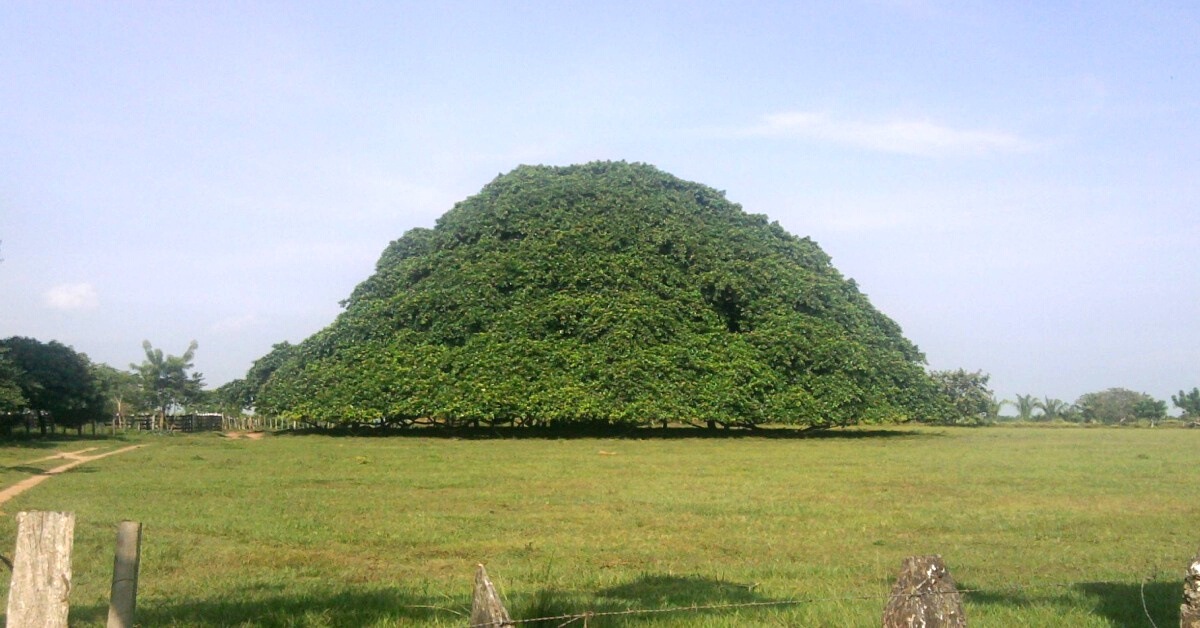Wow, that’s not a small hill, it’s actually a giant tree! Have you ever wondered what the biggest tree in the world is? While General Sherman might come to mind, take a look at this and reconsider.

There is a large tree in the Caribbean region of Colombia that is often confused with another tree called ‘The Tree of Guacarí’. However, the tree we are discussing has its own unique appearance.

Back in the 90s, the Samán of Guacarí, which was a type of Samanea saman tree, used to be depicted on Colombian 500 peso coins. This rain tree sadly met its demise in 1989 due to its bulky branches falling off.

The subject of this article is not the famous Samanea saman tree, but rather a different species that bears a striking resemblance to it. It is a Ficus, commonly known as a fig tree, which is a popular choice for ornamental plants in gardens and homes worldwide. However, this particular tree is exceptional in its size and stature, and is considered the largest tree in Colombia. In fact, it is so enormous that from afar, it appears like a hill, and as you approach it, you can’t help but feel insignificant in comparison. While there is no absolute proof of its dimensions, photos suggest that it may be around 30 meters tall and 75 meters in diameter.

The tree’s foliage is truly stunning, resembling a verdant mountain with branches that seem to bow down in reverence to the earth. These branches, which sprout from the farthest reaches of the trunk and extend downwards, act as natural pillars that the tree has created through its own aerial roots.

The Tree of San Marcos is an amazing sight to behold as it boasts massive foliage that is supported by pillars. According to Viajar en Verano, standing under this colossal tree gives the feeling of being in the basement of a grand building with numerous columns holding up the enormous mass. Some Latin Americans refer to it as ‘The Tree That Walks’ due to its ‘feet’ which facilitate its expansion. The tree has grown pillars that resemble limbs, and it uses them to spread out its branches to receive more sunlight or locate more fertile soil to nourish itself. Interestingly, the Tree of San Marcos is not a single tree but rather several trees intertwined together.

Raúl Ospino Rangel, a historian, provides a fascinating account of the origin of a unique green mass. The story began in 1964 when the proprietor of the Αlejandría farm endeavored to safeguard a young yellow cedar tree that he had planted. To prevent cattle from harming the sapling, six fig tree rods were erected around it. However, this seemingly protective measure resulted in the emergence of buds and branches on the fig tree struts, which ultimately overwhelmed and assimilated the yellow cedar. This phenomenon led to the formation of a remarkable entity – not just one tree, but six trees entwined and unified into a single, awe-inspiring organism. Image credit: Viajar en Verano.

The ‘Giant Fig of San Marcos’ is actually a group of six plants that have intertwined and grown together using their aerial roots to create a strong support system on the ground. If you ever find yourself on the Atlantic coast of Colombia, make sure to stop by San Marcos and experience the shade of ‘The Most Beautiful Tree in Colombia’. You can spot it from a distance, as it stands out like a green mountain about three kilometers before reaching the Alejandría farm. While standing under the protection of this tree, one cannot help but feel small, yet empowered by its immense energy. Let us hope that it remains standing for many years to come.
